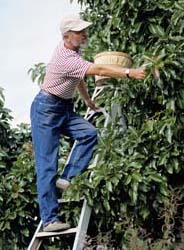Falls
|

|
If you are under 16 years old,
Child Labor Laws
forbid you from working on a ladder or scaffold over 20 feet high; state
child laws may be even more stringent.
|
Do You Know... falls
are the most common accident in agriculture? Falls often result in serious
injuries or death. Falls of just 12 feet can kill you. Many
falls occur because of slips and trips and can be avoided by wearing proper shoes and
following safe work procedures.
|
|

|
More than a million people suffer from a slip, trip or falling injury each year;
over 11,000 die as a result of falls alone. |
|
|
Teen Safety Solutions |
Employers have the primary responsibility for protecting the safety
and health of their workers. Employees are responsible for following
the safe work practices of their employers.
|
To help prevent falls:
- Wear shoes and boots with slip-resistant soles and heels.
- Remove tools or other items that may cause a tripping hazard from equipment.
- Keep platforms, foot-plates, and steps clear of mud, snow, manure, or other debris.
- Do not get out of equipment such as
a tractor before it has completely stopped and the brakes are set. Step down
using handholds or rails. Never jump off a tractor (moving or
not) except if tractor comes into contact with energized power
lines, then jump as far away as possible and shuffle away from
where you jumped.
- Examine ladders to ensure they are in good
condition. Wood ladders should not be painted because this may
disguise flaws or weak areas in the wood. Use the "four-to-one rule" for straight ladders,
setting the ladder base one foot from a wall or building for
each four feet in height.
- When working on ladders:
- Lock a leg around the ladder if you need to use both hands.
- Do not overreach.
- Keep your belt buckle between the ladder rungs
.
- Do not put one foot on the ladder and the other on an adjacent surface or object.
- Do not jump down.
- Avoid climbing a ladder in wet or icy conditions.
- Be aware of power lines and avoid them.
- Do not work in a high places when the weather is windy or
stormy or when you are ill, tired, or taking strong medication.
|
 |
|
| Employer Safety Solutions
|
Employers have the primary responsibility for protecting the safety
and health of their workers. Employees are responsible for following
the safe work practices of their employers.
Follow
the Fair Labor Standards Act (FLSA)
including:
 |
- Some agricultural jobs are too dangerous for anyone under 16 to perform. No
youth under 16 years of age may be employed at any time in any
of these Hazardous Occupations in Agriculture
(HO/A); operating or helping to operate, starting, stopping, adjusting, feeding or any other activity involving physical
contact with the following machines:
-
HO/A #2,
Corn picker, cotton picker,
grain combine, hay mover, forage harvester, hay baler, potato
digger, mobile pea viner, feed grinder, crop dryer, forage
blower, auger conveyor, power post-hole digger, power post
driver, nonwalking type rotary tiller, or the unloading
mechanism of a non-gravity-type self-unloading wagon or trailer.
-
HO/A #3,
Trencher or earth moving equipment, forklift, potato
combine, or power-drive circular, band or chain saw.
-
HO/A #4, Working on a farm, in a
yard, pen or stall occupied by a bull, boar, or stud horse
maintained for breeding purposes; or sow with suckling pigs, or
cow with newborn calf with umbilical cord present.
-
HO/A #6, Working from a ladder
or scaffold at a height of over 20 feet (working includes
painting, repairing, or building structures, pruning trees,
picking fruit, etc.).
|
Consider implementing recommended safe work practices, including:
To avoid trips and falls by workers:
- Perform preventative maintenance on
equipment in the off-season. Trips and falls occur much more
frequently when you are in a hurry.
- Encourage workers to practice safety by cleaning
dust and debris from steps or platforms.
- Keep entrances to buildings clear. Be sure
steps to equipment are free of mud, ice, and snow build-up.
- Allow extra time to feed livestock and hitch
equipment in muddy or wet conditions
.
- Encourage workers to wear shoes with a solid, slip-resistant
tread. Good traction reduces the chance of slipping and
falling.
- Maintain all ladders in good condition.
- Use locking covers or pull-down section for the first
6 to 8 feet of permanent ladders to prevent unauthorized access.
- Surround permanent ladders longer than 20 feet with a safety
cage that will support the weight of two workers. The
American Society of Agricultural Engineers also recommends
construction of rest or work platforms at 30-foot intervals.
OSHA's construction etool provides more information on
ladder safety:
- Install handrails above the end of vertical exterior ladders
on grain bins to help workers get on and off the ladder. Each handrail should be able to support the weight of one
worker.
- Install guardrails along roof ladders and around the
center roof cover on center roof opening grain bins.
- Consider using stair treads instead of a roof ladder and a level
platform instead of roof cleats around center roof covers to
provide a safer footing.
- Consider installing and using equipment to prevent serious injuries
such as a
waist belt or body harness and lanyard to limit the distance a
worker can fall. A body harness will spread the force of a fall over a larger
part of the body than a waist belt. Be sure the harness will fit all the
workers who use it.
- Store safety ropes carefully. Sunlight, moisture, and
some chemicals will reduce the strength of rope. Safety
specialists recommend that safety ropes be replaced every seven years even if they do not appear to be damaged.
|
|
|
|
Additional Information:
|
|

